DVP Group Assignment
Our initial idea for the video was a pre-finals nightmare, solidly based on a reality where everything at school is broken when it’s most needed. We wanted to channel the anxiety of needing to print and submit files, running from one room to another, and dropping papers along the way. Getting various shots of Elena running was critical, as well as close ups of her hands and face. I was inspired by the film analyses of Pans Labrynth and Dark Night. I noted how little the camera stayed still. It was constantly in motion, even if just a slow sweep in one direction or the other. I wanted to create something dynamic, with smooth cut scenes and fluid movements.
Lauren, Elena, and I all had very similar storyboards. The story: Elena during finals, with everything going wrong (the computer freezing, the printers down, the paper cutter not working), and ending as she wakes up from the finals nightmare.
Filming was easy. Lauren, Elena, and I all took turns shooting footage, and were able to agree on the most important scenes. Lauren’s background in film was a trememdous help when it came to dynamic camera movement and abstract shots. The snorri-cam and tracking shots were lots of fun to shoot as well. The only challenges that arose came about from the other people in the room. We had to film around them, and migrate to multiple areas within the 8th floor if our previous spot was taken over.
When it came to editing, I realized that I didn’t have all of the shots i wanted, but I also didn’t want to create a straightforward narrative. I almost completely threw out the storyboard and had to start from scratch. In the beginning, editing was difficult, only because I wasn’t sure what direction to take with the story. I started looking for “spooky music” and created the movie based on what I found. In the background, there is ambient electronic buzzing music and Tibetan singing bowls. To my surprise, much of the raw audio we captured from the camera was usable as well. The use of sound and music allowed me the flexibility to have blacked out areas of the screen, while still progressing the story.
One things that surprised me the most was how different each of the videos turned out. Elena’s video was humorous, while Laurens was moody. Much of the footage I omitted, they used. It was also interesting to see how sound could transform the same footage in such different ways: the use of ambient noise versus dramatic Vivaldi concertos, or sound effects versus the absence of.
There’s no particular reason that a Jackelope was the first idea to come to mind when given the puppet assignment. I suspect, there were two possible reasons for inspiration: a recent podcast I listened to or an Autumn homesickness from bunny-laden Michigan.
Initially, I wanted to create a skeletal creature which would closely resemble an anatomical rabbit. Creating the vertebrae out of epoxy turned into more of an ordeal than I had thought it would be. Lack of clear reference photos or access to an actual skeleton made it extremely difficult to create anything passably realistic. However, the Sculpey teeth I made were quite nice.
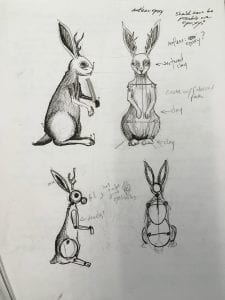
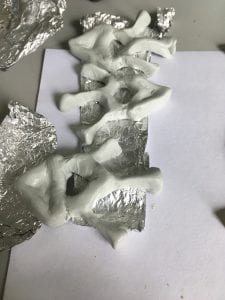

Next was the head. I used foil and masking tape to build the bulk of the head. I then used armature wire and masking tape to build up the antlers and ears. When the basic form was complete, I used an awl to puncture holes in the jaw for teeth, and secure everything in place with epoxy. The ears and antlers were reinforced with epoxy clay as well.
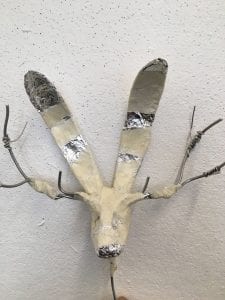
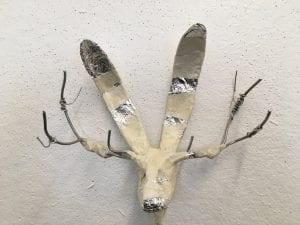
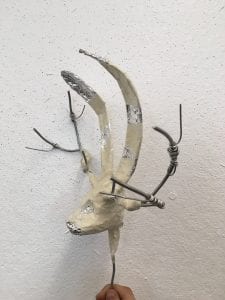
The body was a challenge. I had to compromise between making a form that was more rabbit-like or more human like. I opted for the latter. I wanted the Jackelope to be able to stand on two legs, but with the joint configuration in the hind legs that would allow it to also sit on all fours. Youtube was an invaluable source for figuring out ways to make the joints of the skeleton. I created loops from heavy gauge armature wire to use to latch the joints together. The skeleton frame was then covered in foil and masking tape. I had to pay careful attention to the way the joints would bend. To ensure that the limbs would not move in every direction, I had to build in “stops.” This meant adding layers of foil to ensure that joints only had clearance to move in one direction or the other.
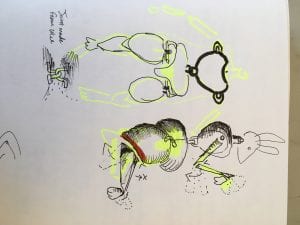
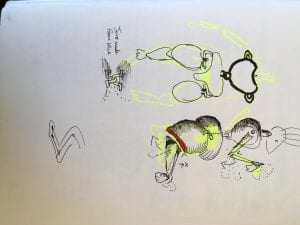
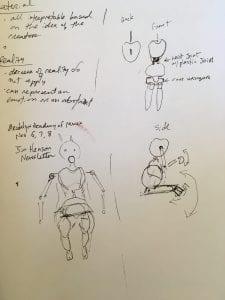
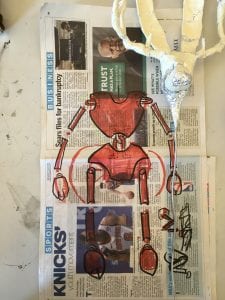
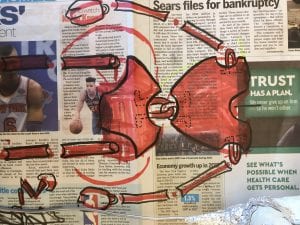
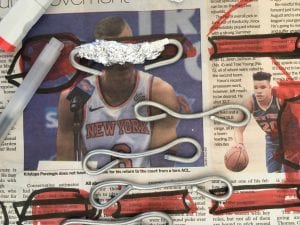
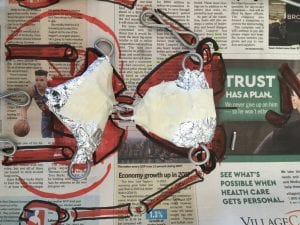
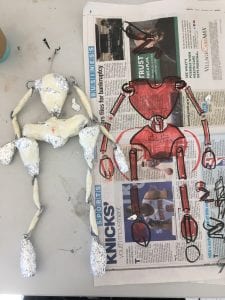
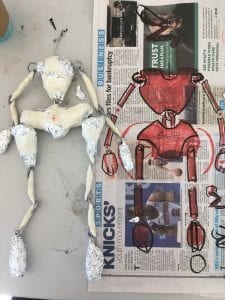
I made the choice to only make the paws and head of the Jackelope detailed, because everything else would be covered with some sort of fabric. I used epoxy clay to cover the surface of the paws, and scored the surface to give the appearance of fur. I used acrylic paint to cover the surfaces that would be visible.
When faced with the problem of covering the frame I quickly remembered that sewing is awful and I hate it. 3 garments were destroyed in the process of experimentation. After collapsing in a pile of frustration and fabric scraps, I decided that gutting a stuffed animal would be the easiest option to maintain some amount of my sanity. The sacrificial stuffed sloth i found was imperfect but usable. The skin and Jackelope frame both required modifications though: the frame was too wide, and the limbs of the skin were too short. I used a hammer to compress the foil layers in the pelvis and thighs. For the skin, I extended both the arms and legs using leftover fabric (and minimal sewing). Fuzzy fabric is very forgiving, and I was able to Frankenstein a suit together, plu8s re-use some of the stuffing to make the Jackelpoe pleasantly squeezable.

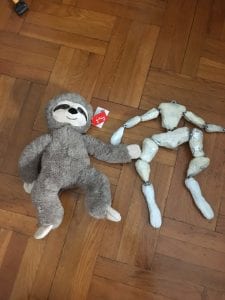
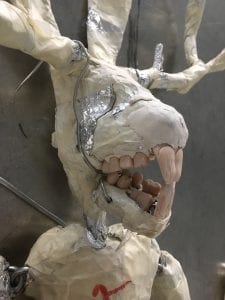


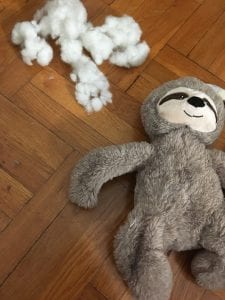
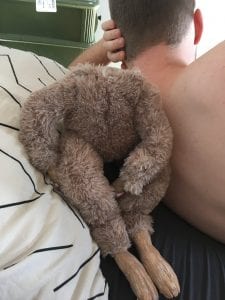
I was unsure what to do for eyes. Again, I was torn between a realistic or an obviously fabricated solution. I thought about using clay, beads, or just leaving the sockets empty, and then decided to repurpose the eyes of the Sloth. I used Epoxy clay to build up the eye sockets a little more and then put the cloth eyes in place.
The headless Jackelope was quite fun to play with. I attached some throwaway string to the body, just to see how the puppet would move. Paul Andrejco mentioned during his lecture that puppet creations sort of have a mind of their own. My headless Jackelope was floppy and grotesque like a raw chicken. I loved him.
The last issue was attaching the stings to the controller. The string I was originally using kept tangling or breaking. I ended up getting super thick fishing wire, which once attached, looked like overkill. I’m not sure what professional puppeteers do to keep their strings from tangling, but I definitely see the fishing wire as a temporary solution for now.
I am very happy with how my puppet turned out. My favorite aspect of creating 3D work is how tactile it is, and how it invites the viewer to play and explore. I plan to use more 3d elements in my work in the future, but for now, I have a Jackelope to hang out with.
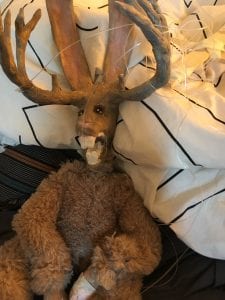
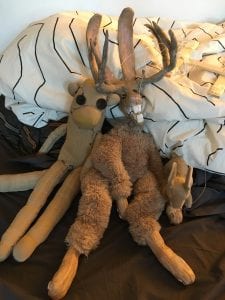
In the spirit of Halloween, I had an idea to create something eerie, perhaps bordering violent. For me, the mask I created was not meant to transform the wearer, but to absorb them. A multitude of hands reach over the face, obscuring an eye, and cradling the chin. I imagined this mask as a physical manifestation of mental illness, constantly pulling the wearer back into some dark abyss.
To create the mask, I began with a wire frame headband. My boyfriend acted as a *mostly* willing mannequin, who held still while I bent wire around his head and repeatedly (but accidentally) stabbed him with loose wires. The hands were all created individually as well, comprised of wire armatures and masking tape.
I covered both the hands and the headband with foil to build up volume, and used paper pulp to build even more volume. Epoxy clay was used to create fingernails and to hold together some loose joints. The exterior was mostly covered with white paper clay.
Instead of attempting to paint the hands “flesh color,” I wanted to leave them grey and white. The rawness of the paper clay and paper pulp created a wonderful texture that I couldn’t bring myself to cover up.
I imagine my hand mask being used as a movie prop, in dimly lit rooms, and only for split second cut scenes. Hopefully, the quick cut scenes would lead the viewer to question whether or not they actually saw it.

Preliminary sketches for possible masks.





Ben was less than enthused to model for me after I woke him up to do so.







































